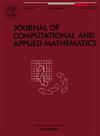Multiscale model reduction for the time fractional thermoporoelasticity problem in fractured and heterogeneous media
Abstract
In this paper, we consider the time fractional thermoporoelasticity problem in fractured and heterogeneous media. The mathematical model with a time memory formalism is described by a coupled system of equations for pressure, temperature and displacements. We use an implicit finite difference approximation for temporal discretization. We present a fine grid approximation based on the finite element method and Discrete Fracture Model (DFM) for two-dimensional model problems. Further, we use the Generalized Multiscale Finite Element Method (GMsFEM) for coarse grid approximation. The primary concept behind the proposed method is to streamline the complexity inherent in the thermoporoelasticity problem. Given that our model equation incorporates multiple fractional powers, leading to multiple unknowns with memory effects, we aim to address this intricacy by optimizing the problem’s dimensionality. As a result, the solution is sought on a coarse grid, a strategic choice that not only simplifies the computational cost but also contributes to significant time savings. We present numerical results for the two-dimensional model problems in heterogeneous fractured porous media. We derive relative errors between the reference fine grid solution and the multiscale solution for different numbers of multiscale basis functions. The results confirm that the proposed method is able to achieve good accuracy with a few degrees of freedoms on the coarse grid.

 求助内容:
求助内容: 应助结果提醒方式:
应助结果提醒方式:


